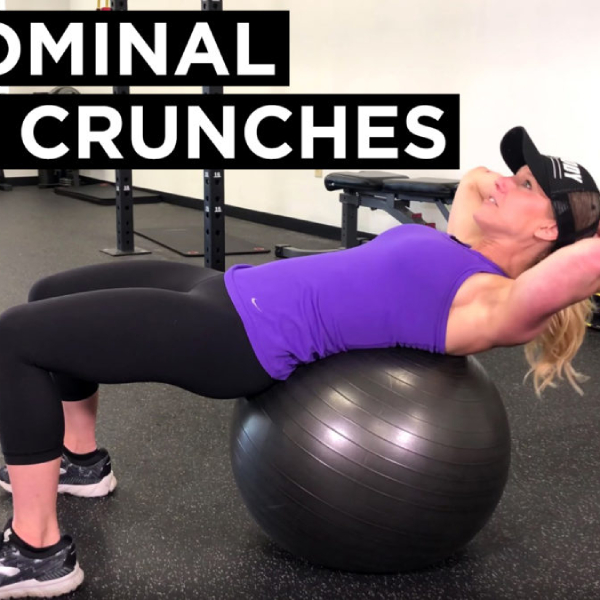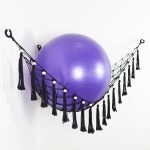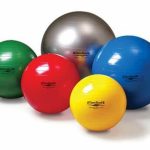The Role of Yoga Ball Crunches in Core Strengthening
Yoga ball crunches are vital for a stronger core. They work by making your body maintain balance on an unstable surface. This engages your stabilizer muscles, especially in the core area. These exercises target multiple muscle groups in your abdomen. They include the rectus abdominis, transverse abdominis, and obliques. This comprehensive muscle engagement helps build a stronger, more defined core. Using a yoga ball holder can enhance your workout experience, providing stability during yoga ball crunches and allowing you to focus more on engaging your core muscles effectively.
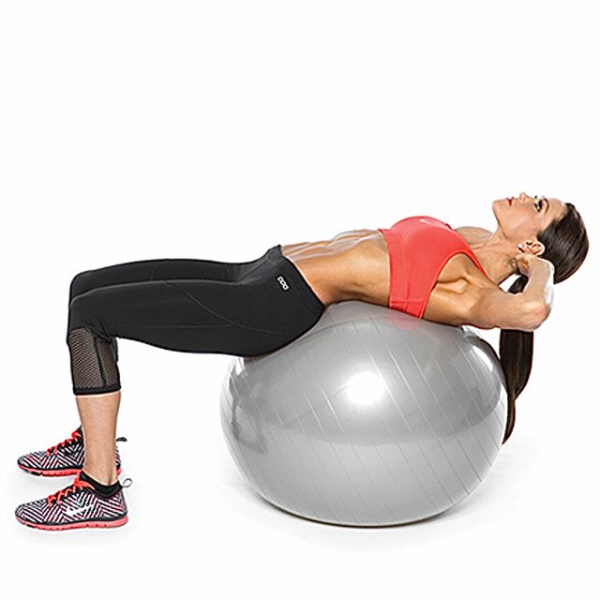
When you perform crunches on a yoga ball, your range of motion increases. This leads to a better stretch and contraction of the abdominal muscles. As your core controls the stability on the ball, it becomes more powerful. The crunches tone and strengthen the abs and lower back. These are key for good posture and back health.
Enhance Your Core Workout with Yoga Ball Crunches
Yoga ball crunches also offer variety to your workout. They can make core training more interesting and less monotonous. Studies show that the activation of core muscles is higher in ball crunches. This is in comparison to traditional crunches done on the floor. Incorporating yoga ball crunches into your routine not only enhances core muscle activation but also brings diversity to your workouts; for optimal results, refer to a yoga ball size chart to ensure you’re using the correct ball for your height.
Adding yoga ball crunches to your routine can help you progress. They offer benefits that other core exercises may not. For instance, these exercises do not put unnecessary pressure on your spine. This makes them suitable for many people.
To sum up, yoga ball crunches boost core strength. They offer a dynamic range of motion, improve balance, and activate your entire core. Incorporating them into your routine can lead to a stronger and more defined midsection.
Understanding Core Muscles Targeted by Yoga Ball Crunches
When embarking on a core strengthening journey with yoga ball crunches, it’s critical to understand the specific muscle groups these exercises engage. Here we will delve into the core muscles that are vital for a strong and stable midsection.
Rectus Abdominis
The Rectus Abdominis is the muscle that gives you the six-pack appearance. It runs down the front of your abdomen from the rib cage to the pelvis. Yoga ball crunches intensely work this muscle, enhancing its strength and definition.
Transverse Abdominis
This is your deepest abdominal muscle, acting like a corset around your midsection. It stabilizes your core and supports your organs. By doing crunches on a yoga ball, you activate and tone the Transverse Abdominis.
Internal and External Obliques
These muscles are on the sides of your abdomen, wrapping around your waist. They allow you to twist and bend sideways. Using a yoga ball emphasizes the engagement of these muscles, which helps sculpt your waist and improve your trunk rotation. To enhance your waist sculpting and trunk rotation exercises, consider incorporating the best yoga ball into your routine, as it effectively engages the abdominal muscles located on the sides of your waist.
Understanding the roles of these core muscles is key to maximizing the effectiveness of your yoga ball crunches. Not only will this knowledge enhance your technique, but it also provides insight into how these exercises contribute to core stability and overall athletic performance.
Step-by-Step Guide to Performing Yoga Ball Crunches
Performing yoga ball crunches correctly is essential to their effectiveness. Follow these steps to ensure you’re getting the most out of your workout.
- Choose the Right Size Ball: The ball should be big enough so that when you sit on it, your knees bend at a 90-degree angle.
- Starting Position: Sit on the yoga ball with your feet flat on the ground, shoulder-width apart. Begin to walk your feet forward as you lean back. Stop when the ball is under your lower back.
- Ensuring Correct Form: Place your hands behind your head or across your chest. Avoid pulling on your neck.
- Performing the Crunch: Exhale, engage your core, and lift your upper body. Keep the movement smooth and controlled.
- Maximum Contraction: Curl up until your shoulder blades are off the ball. Hold for a moment to feel the full contraction of your abs.
- Returning to the Start: Inhale and slowly lower yourself back down to the ball. Your back should gently re-arch over the ball.
- Repetition: Aim for 10 to 15 crunches per set to start with. Increase as you get stronger.
Remember, slow and controlled movements target your muscles more effectively than rapid, erratic ones. Take the time to feel each crunch and maintain proper form throughout.
Advantages of Incorporating Yoga Ball Crunches into Your Routine
Incorporating yoga ball crunches into your workout brings many benefits. This simple yet effective tool can revamp your fitness regimen. Let’s explore the advantages of adding this exercise to your routine.
- Improved Muscle Activation: Studies, like the one from Occidental College, show a 24% to 38% increase in abdominal muscle activation during yoga ball crunches compared to traditional floor crunches. This means your core works harder and gets stronger.
- Enhanced Balance and Stability: The unstable surface of the yoga ball means your body must work to maintain balance. This effort engages not only the core muscles but also those involved in stabilization, like your hips and lower back.
- Reduced Spinal Stress: Unlike hard surfaces, the cushioned yoga ball is gentle on your spine. This makes crunches less taxing on your back, allowing for a more comfortable exercise experience.
- Increased Range of Motion: The ball’s shape lets you extend further, providing a deeper stretch and contraction for your abs. This helps in developing strength alongside muscle definition.
- Versatility in Workouts: With yoga ball crunches, you can easily adjust the exercise’s intensity. Add weights or try different variations to keep your muscles challenged. This adaptability prevents workout plateaus.
- Core Endurance: As you fight to stay balanced on the ball, your core endurance improves. This has a positive impact on your overall fitness and helps in performing daily activities with ease.
- Accessible for All Levels: Whether you’re a beginner or an advanced athlete, yoga ball crunches are suitable. They offer a range of difficulties from basic crunches to advanced movements with added resistance.
Using yoga ball crunches in your ab workouts can boost muscle growth and core stability. Remember to maintain proper form to reap all these benefits while minimizing the risk of injury.
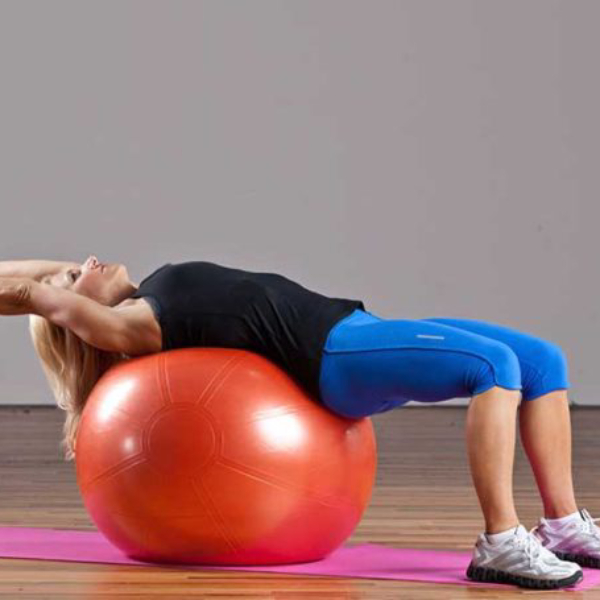
Common Mistakes and Safety Tips for Yoga Ball Crunches
To optimize the benefits of yoga ball crunches and prevent injuries, it’s crucial to be aware of common mistakes and adhere to safety guidelines.
Avoiding Incorrect Posture
One common error is improper positioning on the ball, which can reduce effectiveness and pose injury risks. Ensure the ball is under your lower back and maintain a neutral spine to avoid strain.
Not Overextending the Neck
Another mistake is straining the neck by pulling it with your hands during the crunches. Always keep your gaze upwards and your neck in line with your spine.
Keeping Movements Controlled
Rushing through the movements can lead to a loss of form and decreased muscle engagement. Practice slow, deliberate motions to target your core muscles effectively.
Staying Centered on the Ball
Shifting too far forward or backward on the ball can compromise your stability. Strive to stay centered to maintain balance and proper muscle activation.
Gradually Increasing Intensity
Begin with simple crunches before attempting more challenging variations or adding weights. This progression helps build core strength safely.
Using the Correct Size Ball
The size of your yoga ball should allow your knees to be at a 90-degree angle when seated. Using a ball that’s too large or too small can lead to poor form.
Safety Tips for Prevention of Injuries
Warm-Up Appropriately
Engage in a light cardio session or dynamic stretching routine before starting your yoga ball exercises to prepare your muscles.
Listen to Your Body
If you experience pain or discomfort, especially in the lower back, stop and reassess your form or consult with a fitness professional.
Ensure a Stable Environment
Practice on a non-slip surface and remove any nearby objects that could cause you to lose balance or sustain an injury.
Keep Hydrated
Drink water before, during, and after your exercise session to maintain muscle function and aid recovery.
Cool Down
After your workout, perform light stretching to relax your muscles and promote flexibility.
Through mindful practice and the avoidance of common mistakes, yoga ball crunches can be a safe and effective way to build a strong, stable core.
Variations of Yoga Ball Crunches for Enhanced Engagement
Exploring different variations of yoga ball crunches can amplify core engagement and prevent workout boredom. Here are several effective variations that can shake up your routine and target your core from multiple angles.
Weighted Yoga Ball Crunch
Adding weight increases the challenge for your core muscles. Begin as you would with a regular yoga ball crunch. Hold a dumbbell or weight plate across your chest for added resistance.
Oblique Yoga Ball Crunch
Shift focus to your side abdominals. Lean back on the ball with your torso turned slightly. Crunch upwards, engaging your obliques. Alternate sides to maintain balance in muscle development.
Stability Ball Jackknife
This advanced variation starts in a plank position with your feet on the ball. Pull your knees towards your chest, rolling the ball forward. This targets your lower abs and enhances stability.
Ball Pass Crunch
Begin by lying flat on your back, holding the yoga ball with your hands. As you crunch up, pass the ball to your feet and lower back down. Lift your legs and pass the ball back to your hands on the next crunch.
Pike Crunch
Another challenging variation is the pike crunch. Start in the plank position with feet on the ball. Instead of bending the knees, keep your legs straight as you lift your hips upwards into a pike position.
Each variation can help maintain your core’s strength and bring a refreshing challenge to your workout. Always perform exercises with proper form to maximize benefits and reduce the risk of injury. As you get stronger, try increasing the difficulty or adding more repetitions to continue your progress.
Complementing Yoga Ball Crunches with Other Core Exercises
To build a strong, well-rounded core, it is beneficial to add variety to your workout routine. Complementing yoga ball crunches with other core exercises ensures that you’re not only working your abs but also the supporting muscles around them. Here are a few exercises to include alongside your yoga ball crunches:
- Planks: This exercise targets the entire core, including the shoulders and glutes. Make sure to keep your body in a straight line from head to heels.
- Russian Twists: Using a medicine ball or free weight, perform seated twists. This engages the obliques and helps with rotational strength.
- Leg Raises: Lie flat on your back and raise your legs straight up then lower them slowly. This works the lower abdominal muscles effectively.
- Bicycle Crunches: Alternate between touching your elbow to the opposite knee in a cycling motion to target the rectus abdominis and obliques.
- Mountain Climbers: Start in a plank position and alternate bringing your knees to your chest. This not only works the core but also raises your heart rate.
By combining these exercises with yoga ball crunches, you target different muscle groups. This helps in creating a balanced core workout. Always pay attention to your form and control your movements for the best results. Adding different exercises also keeps your workout exciting and can help you stay motivated.

Nutrition and Lifestyle Tips to Support Your Core Workout
Enhancing your core strength with yoga ball crunches is just one aspect of building a strong, toned midsection. Nutrition and lifestyle habits play a crucial role too. Here’s how you can support your core workout for better results.
Eat Balanced Meals
Focus on eating balanced meals that include a mix of protein, carbohydrates, and healthy fats. These nutrients support muscle growth and recovery.
Stay Hydrated
Drink plenty of water throughout the day. Hydration is key for muscle function and recovery after workouts.
Get Enough Sleep
Aim for 7-9 hours of quality sleep each night. Sleep aids muscle repair and growth, essential for a strong core.
Manage Stress
High stress levels can affect workout results. Engage in activities that reduce stress, like reading or meditating.
Limit Processed Foods
Reduce the intake of processed foods. They often lack nutrients and may lead to weight gain.
Include Core-friendly Foods
Include foods that are good for your abs, like leafy greens, nuts, and lean proteins. These can help reduce bloat and support muscle definition.
Consistency is Key
Stick to a regular workout schedule. Consistency leads to better muscle development and endurance.
Avoid Excessive Alcohol
Alcohol can contribute to weight gain and interfere with recovery. Enjoy in moderation or not at all.
By combining proper nutrition and lifestyle choices with your yoga ball crunch routine, you’ll maximize the impact of your core workouts and pave the way for a healthier, more toned body.
